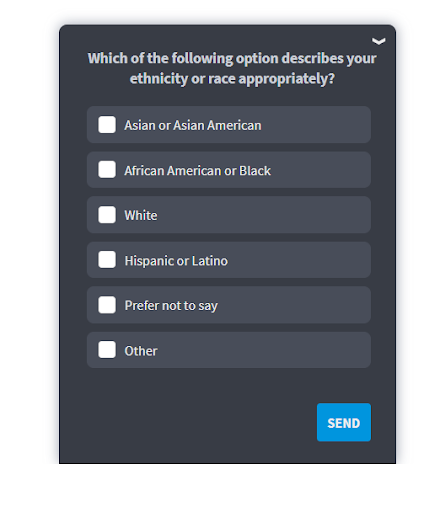Do’s of Creating Website Surveys
1.) Use Closed-Ended Questions Whenever Possible
They are easy to answer and don't take much time. Plus, since these questions offer specific choices to the respondents, it makes them easier to analyze. Some of the closed-ended question types are:
- Single choice
- Multiple choice
- Yes/No question (Dichotomous question)
- Emoji or rating
- Matrix matching
- NPS scale
2.) Keep Your Rating Scale Consistent
Let's say you use a website satisfaction survey question with a Likert scale whose response anchors range from 'very dissatisfied' to 'very satisfied,' make sure you use the same scale order throughout the survey. It ensures that the customers don't get confused and makes it easier for you to analyze the responses.
3.) Always Pre-Test Your Surveys
Yes, we are repeating it because it is that important. Testing helps you weed out unseen issues or mistakes in your survey. It makes sure that the data you collect is true and free of bias.
4.) Add a Progress Bar to the Surveys
A progress bar shows the respondents how much distance they have covered. It reduces visitors' tendency to get annoyed and leave the survey without finishing it.
5.) Use Visual Aids Wherever Possible
Visual aids such as images or videos help respondents jog their memory and respond better to the questions. If you want to know their views on some idea, present it via an image, video, a chart, etc., so they can visualize it themselves and give accurate feedback.
Don’ts of Creating Website Surveys
1.) Overloading With Questions
Imagine an e-commerce site bombarding customers with a lengthy survey during the checkout process, asking about irrelevant details such as shoe size when purchasing a book.
Flooding your survey with an abundance of questions, while well-intentioned, can lead to respondent frustration.
When it comes to how many questions should a survey have, consider the relevance of each question. If some queries won't contribute significantly to your data pool, exclude them.
Employ skip logic to tailor questions to specific respondents or break down extensive surveys into shorter, more manageable sections.
Alternatively, strategically integrate brief surveys at different customer touchpoints along their journey. Start with your survey goals in mind and align survey questions accordingly, discarding any that don't align with your objectives.
2.) Framing Assumptive and Leading Questions
Formulating questions based on assumptions can jeopardize the reliability of your survey. While these questions may seem logical to you, they might confuse respondents who lack your level of knowledge.
To identify assumptive questions, analyze each one for contextual assumptions. Consider seeking input from an unbiased individual matching your customer profile. In the context of a hotel chain, avoid questions assuming guests' preferences without their explicit input.
Example: Asking, "Considering the superior comfort of our deluxe suites, how likely are you to recommend our hotel?" assumes the respondent has experienced the deluxe suites, potentially leading to skewed results.
Here’s another example:
3.) Lack of Opt-out Options
Failing to offer an opt-out or skip option for sensitive questions can lead to survey abandonment or random responses. Some respondents may be uncomfortable answering questions related to race, income, ethnicity, or religion.
Provide an opt-out choice or an alternative response like "I prefer not to say." Implement skip logic to empower participants to skip sensitive questions without compromising the overall survey experience.
Example: A survey probing into personal details without an option to skip or select "prefer not to say" may deter respondents, affecting the accuracy and reliability of the collected data.
You can check out our exhaustively detailed article on “Common Types of Survey Errors and How to Correct Them” for more information.




